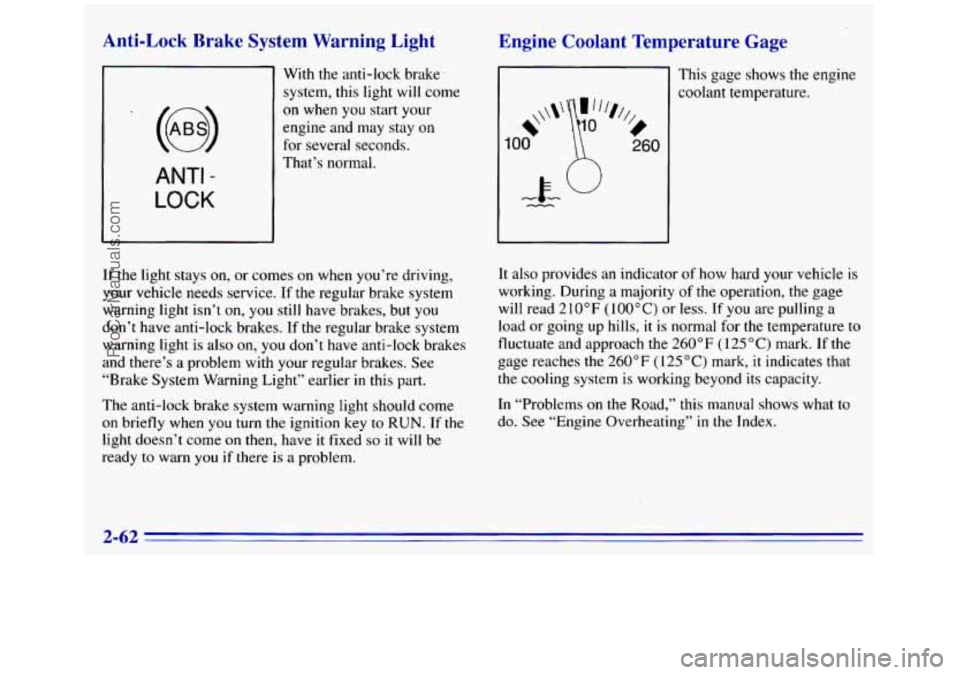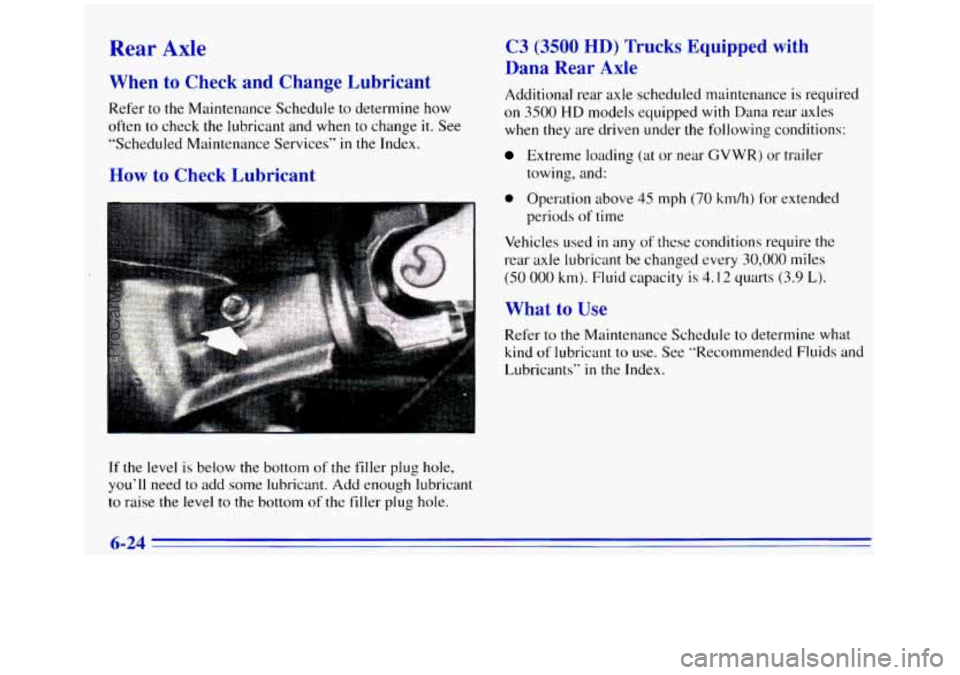Page 124 of 404

ANTI -
LOCK
Qnti-Lock Brake System Warning Light
With the anti-lock brake.
system, this light will come
on when
you start your
engine and may stay on
for several seconds.
That’s normal.
If the light stays on, or comes on when you’re driving,
your vehicle needs service.
If the regular brake system
warning light isn’t on,
you still have brakes, but you
don’t have anti-lock brakes.
If the regular brake system
warning light is also on, you don’t have anti-lock brakes
and there’s
a problem with your regular brakes. See
“Brake System Warning Light” earlier
in this part.
The anti-lock brake system warning light should come
on briefly when you turn the ignition key to RUN. If the
light doesn’t come on then, have it fixed so it will be
ready to warn
you if there is a problem.
Engine Coolant Temperature Gage
I This gage shows the engine
~ coolant temperature.
It also provides an indicator of how hard your vehicle is
working. During a majority of the operation, the gage
will read 210°F
(100°C) or less. If you are pulling a
load or going up hills, it is normal for the temperature to
fluctuate and approach the 260°F ( 125 “C) mark. If the
gage reaches the 260°F
(I 25 “C) mark, it indicates that
the cooling system is working beyond its capacity.
In “Problems
on the Road,” this manual shows what to
do. See “Engine Overheating” in the Index.
2-62
ProCarManuals.com
Page 196 of 404

Loading Your Vehicle
n ", ,. , I --- SEE OWNER'S MANUAL FOR ADDITIONAL INFORMATION I U
The Certificatiomire label is found on the rear edge of
the driver's door or in the Incomplete Vehicle Document
in the cab.
The label shows the size of your original tires and the
inflation pressures needed to obtain the gross weight
capacity
of your vehicle. This is called the GVWR
(Gross Vehicle Weight Rating).
The GVWR includes the
weight of the vehicle, all occupants, fuel and cargo.
The Certificationmire label also tells
you the maximum
weights for the front and rear axles, called Gross
Axle
Weight Rating (GAWR). To find out the actual loads on your
front and rear axles,
you need to go to a weigh
station and weigh your vehicle. Your dealer can help
you with this. Be sure to spread out your load equally on
both sides of the centerline.
Never exceed the GVWR for your vehicle, or the
GAWR for either the front or rear axle.
And,
if you do have a heavy load, you should spread
it
out.
I
In the case of a sudden stop or collision, things
carried in the bed
of your truck could shift
forward and come into the passenger area,
injuring you and others.
If you put things in the
bed
of your truck, you should make sure they are
properly secured.
Using heavier suspension components to get added
durability might not change your weight ratings. Ask
your dealer to help you load your vehicle the right way.
4-42
ProCarManuals.com
Page 207 of 404

(2-3500 HDiChassis .Cab Engine (Trans.) Axle Ratio
Max. Trailer Wt.
5.7L 4.63 8,500 lbs. (3 859 kg)
5.13
8,500 lbs. (3 859 kg)
6% Diesel
(Auto.)
6.5L Diesel
(Manual)
7.4L 4.63
5.13
4.63 5.13
4.63
5.13
8,000 lbs. (3 632 kg)
10,500 lbs.*
(4 767 kg)
7,000 lbs. (3 178 kg)
8,500 lbs. (3 859 kg)
12,500 lbs.*
(5 675 kg)
12,500 lbs.*
(5 675 kg)
*Fifth wheel hitch rating; weight distributing hitch
rating is limited to 10,000 lbs. (4 540 kg). You
can ask your dealer for our trailering information or
advice, or you can write us at the addreis listed in your
Warranty and Owner Assistance Information Booklet.
In Canada, write to:
General Motors of Canada Limited
Customer Assistance Center
1908 Colonel Sam Drive
Oshawa, Ontario LlH 8P7
Weight of the Trailer Tongue
The tongue load (A) of any trailer is an important
weight to measure because it affects the total or gross
weight of your vehicle. The Gross Vehicle Weight
(GVW) includes the curb weight of the vehicle, any
cargo you may carry in it, and the people who will be
riding in the vehicle. And if you will tow a trailer, you
must add the tongue load to the GVW because your
vehicle will be carrying that weight, too. S&e “Loading
Your Vehicle” in the Index for more information about
your vehicle’s maximum load capacity.
4-53
ProCarManuals.com
Page 274 of 404

Rear Axle
When to Chc d Change Lubricant
Refer to the Maintenance Schedule to determine how
often to check the lubricant and when to change
it. See
“Scheduled Maintenance Services”
in the Index.
How to Check Lubricant
If the level is below the bottom of the filler plug hole,
you’ll need to add some lubricant. Add enough lubricant
to raise the level to the bottom
of the filler plug hole.
C3 (3500 HD) Trucks Equipped with
Dana Rear
Axle
Additional rear axle scheduled maintenance is required
on 3500 HD models equipped with Dana rear axles
when they are driven under the following conditions:
Extreme loading (at or near GVWR) or trailer
towing, and:
0 Operation above 45 mph (70 km/h) for extended
periods
of time
Vehicles used
in any of these conditions require the
rear axle lubricant be changed every 30,000 miles
(SO 000 km). Fluid capacity is 4.12 quarts (3.9 L).
What to Use
Refer to the Maintenance Schedule to determine what
kind
of lubricant to use. See “Recommended Fluids and
Lubricants”
in the Index.
6-24
ProCarManuals.com
Page 306 of 404

Each new wheel should have the same load-carrying
capacity, diameter, width, offset and be mounted the same way as the one it replaces.
If you need to replace any
of your wheels, wheel bolts
or wheel nuts, replace them only with new
GM original
equipment parts. This way, you will be sure
to have the
right wheel, wheel bolts and wheel nuts for your vehicle.
CAUTION:
I
Using the wrong replacement wheels, wheel bolts
or wheel nuts on your vehicle can be dangerous.
It could affect the braking and handling of your
vehicle, make your tires lose air and make you
lose. control.
You could have a collision in which
you or others could be injured. Always use the
correct wheel, wheel bolts and wheel nuts for
replacement.
NOTICE:
The wrong wheel can also cause problems with
bearing life, brake cooling, speedometer or
odometer calibration, headlamp aim, bumper
height, vehicle ground clearance and tire or tire
chain clearance to the body and chassis.
7
Whenever a wheel, wheel bolt or wheel nut is replaced
on a dual wheel setup, check the wheel
nut torque after
100,
1,000 and 6,000 miles (160, 1 600 and 10 000 km)
of driving. For proper torque, see “Wheel Nut Torque”
in
the Index.
See “Changing a Flat Tire” in the Index for
more information.
6-56
ProCarManuals.com